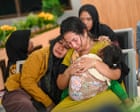
In a world where travel and infrastructure form the backbone of daily life, recent incidents around the globe highlight both the challenges faced in ensuring safety and the resolute efforts to save and support those affected. A ferry sinking near Bali and a building collapse in Pakistan serve as reminders of the unpredictability of life and the importance of rescue operations, which remain vital to mitigating such tragic events.
The incident in Indonesia involved the KMP Tunu Pratama Jaya ferry, a vessel carrying 65 passengers, exclusively Indonesians, on a standard journey from Java to Bali. The journey took a tragic turn when the ferry encountered rough seas late on Wednesday, resulting in its sinking. Rescue teams promptly responded to this calamitous event, managing to rescue 35 individuals while sadly six lives were lost. As rescue operations continue, hope remains for locating the remaining missing passengers. This situation underscores the unpredictable nature of sea travel, compounded by weather changes and their impact on maritime safety. The Indonesian transport ministry has been actively partners with local authorities to ensure the continued safety and rescue efforts in this region.
Simultaneously, in Pakistan, another tragedy unfolded in the Lyari neighborhood, a densely populated and underprivileged district. A significant building collapse occurred on Friday during mid-morning hours. This tragic event claimed the lives of 14 residents, a somber reminder of the structural challenges faced in areas that often lack stringent construction regulations and resources. Emergency services rushed to the scene, providing relief and aid to survivors and those affected by this disaster. The tragic collapse has prompted local authorities to assess building safety standards and improve emergency response mechanisms to prevent such losses in the future.
Both the maritime incident near Bali and the building collapse in Pakistan illustrate the inherent risks associated with natural and man-made structures. However, they also exemplify the resilience and dedication of emergency response teams who work tirelessly to rescue and support those affected, showcasing human capacity for compassion and action in times of need.
With maritime tragedies, factors such as weather patterns come into play, emphasizing the need for robust safety protocols and emergency preparedness. Meanwhile, urban incidents point to the critical importance of implementing and maintaining structural integrity standards, particularly in regions where resources are limited.
The efforts to rescue and recover, though challenging, reflect a larger narrative of community resilience and vigilance. As investigations continue and support is extended to survivors and the families of those lost, these incidents remind us of the collective responsibility to improve safety and preparedness in our global community.
Source: {link}
